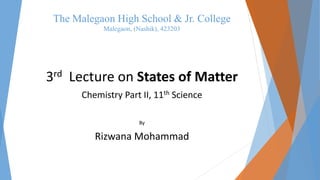
3rd Lecture on States of Matter | Chemistry Part II | 11th Std
- 1. The Malegaon High School & Jr. College Malegaon, (Nashik), 423203 3rd Lecture on States of Matter Chemistry Part II, 11th Science By Rizwana Mohammad
- 2. Characteristic properties of gases: 1. Gases are lighter than solids and liquids i.e. possess lower density. 2. Gases do not possess a fixed volume and shape. They occupy entire space available and take the shape of the container. 3. Gas molecules are in continuous random motion. Therefore gases exert pressure on the walls of the container. 4. Intermolecular forces are weakest 5. Gases possess the property of diffusion. 6. Gases are highly compressible Measurable properties of gases: 1. Mass: The mass, m, of a gas is measure of the quantity of matter it contains. SI unit of mass is kg. Mass of a gas is related to the number of moles, n = mass in grams molar mass in grams = m M
- 3. 2. Volume: Volume of a sample of gas is the amount of space it occupies Units: 1 L = 1000 mL = 1000 cm3 = 1 dm3 1 m3 = 103 dm3 = 103 L = 106 cm3 = 106 mL 3. Pressure: It is defined as force per unit area. Pressure = Force Area = f a 4. Temperature: The degree of hotness or coldness is measured in terms of temperature. Units: degree Celsius (°C), degree Fahrenheit (°F) and Kelvin (K) 5. Density: It is the mass per unit volume d = m V SI unit: kg m-3 6. Diffusion: Diffusion is a spontaneous homogeneous intermixing of two or more gasses. Rate of diffusion: Volume of a gas diffused Time required for diffusion SI unit for rate of diffusion: dm3s-1 or cm3s-1
- 4. Gas Laws 1. Boyle's law: (Pressure - volume relationship) "At constant temperature, the pressure of fixed amount (number of moles) of a gas varies inversely with its volume.” Boyle’s law : Graphical representation
- 5. Mathematical Expression: P ∝ 1 V (at constant T and n) therefore P = k1 1 V K1 = proportionality constant therefore PV = K1 It means that at constant temperature, product of pressure and volume of the fixed amount of gas is constant. If V1 = initial volume P1 = initial pressure V2 = final volume P2 = final pressure According to Boyle’s law P1V1 = P2V2 = constant Boyle’s law in terms of density of gas: We know, PV = k1 therefore V = k1 P …1 But d = m V On substituting V from …1
- 6. d = m k1 P d = k` P Therefore d = k`P k`= New constant Therefore d ∝ P At constant temperature, the pressure is directly proportional to the density of a fixed mass of the gas. 2. Charles’ law: (Temperature, volume relationship): “For an increase of every degree of temperature, volume of gas increases by 1 273.15 of its initial volume at 0°C” Vt = V0 + t 273.15 V0 Vt and V0 are the volumes of given mass of gas at the temperature t°C and 0°C. Vt = V0 1 + t 273.15 Therefore Vt = V0 ( 273.15+t 273.15 ) …1
- 7. At this stage, a new scale of temperature was introduced, the absolute temperature scale. This absolute temperature (TK) was defined as TK = t°C + 273.15 This is also called thermodynamic scale of temperature. Eqn 1 can also be written like Vt = V0 ( Tt T0 ) …2 Where Tt = t + 273.15 T0 = 273.15 On rearranging eqn …2 we get Vt Tt = V0 T0 In general V1 T1 = V2 T2 Therefore V T = constant = k2 Therefore V = k2T …3
- 8. Eqn 3 is mathematical expression of Charles’ law, which is stated as follows: “At constant pressure, the volume of fixed mass of a gas is directly proportional to its temperature in Kelvin.” The lowest temperature that can be imagined but practically cannot be attained. It is the absolute zero temperature on Kelvin Scale. Isobars: A graph of volume temperature Vs absolute temperature at a constant pressure is known as isobar.
- 9. Gay-Lussac’s law (Pressure-temperature relationship): “"At constant volume, pressure of a fixed amount of a gas is directly proportional to its absolute temperature.” Mathematical expression: The law can be as: P ∝ T Therefore P = k3T Therefore P T = k3
- 10. Avogadro law (volume-Amount Relationship): It states that, “equal volumes of all gases at the same temperature and pressure contain equal number of molecules.” The law can be expressed mathematically as: V ∝ n where n is the number of moles of the gas in volume V. V = k4n V n = k4 V n = Constant (at constant temperature and pressure)
